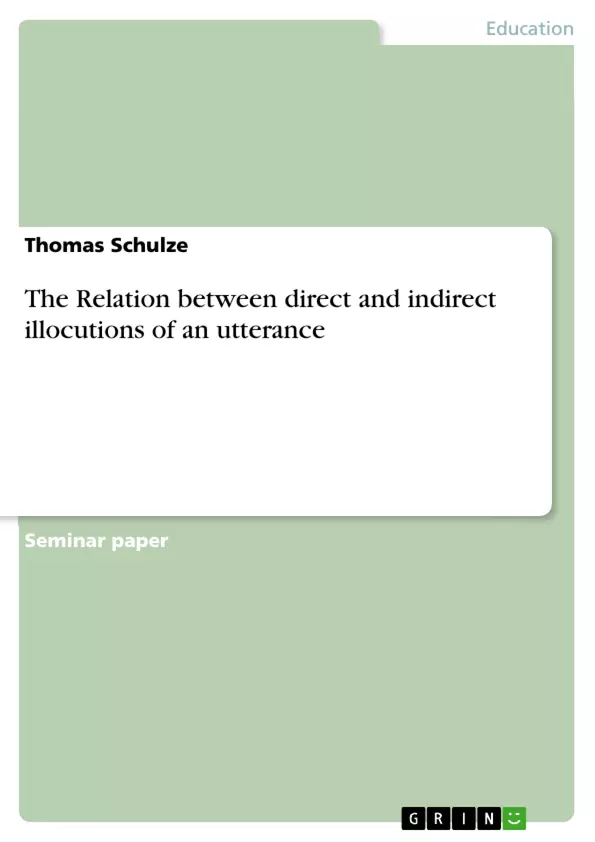If a speaker asks ‘Would you like a cup of coffee?’, how then does the hearer know that this is an act of asking and that it is not an act of, for example, warning? The idea of direct and indirect illocutions, within the field of interpersonal and non-literal meaning in semantics, deals with such questions. Why and in how far can speakers of a language differentiate between the mere literal meaning and reading of an utterance and the meaning beyond this literal form? And how can we form rules and ideas to identify such components in an utterance?
The following essay will therefore concentrate on that question. As a matter of fact, it is therefore necessary to take a look at some other ideas within the field of illocution. The first chapter deals with the act of assertion, the idea of speech acts and the distinction between illocutions and perlocutions. In the second chapter, we will focus on the distinction between direct and indirect illocutions, followed by the third chapter, dealing with the relation between both types of illocutions of an utterance. Direct and indirect illocutions are naturally related in several ways, as we will discuss this point later on.
In fact, direct and indirect illocutions are related in many ways. The following essay will firstly build a basis for that discussion, focus on the need for a distinction between direct and indirect illocutions and finish with a discussion of four possible relations within the field of illocutions. As regards these ideas, the work of Hurford, Heasley and Smith built the basis for this essay. Furthermore, Kreidler’s and Austin’s standard works provided helpful examples and definitions. The work of Leech gave interesting hints at the relation between indirect and direct illocutions and connected them to the field of pragmatics.
Inhaltsverzeichnis (Table of Contents)
- Introduction
- How are the direct and indirect illocutions of an utterance related?
- Assertions, speech acts and the distinction between illocutions and perlocutions
- The distinction between direct and indirect illocutions
- The relation between direct and indirect illocutions.
- Conclusion
Zielsetzung und Themenschwerpunkte (Objectives and Key Themes)
The essay aims to explore the relationship between direct and indirect illocutions in utterances, focusing on their differentiation and the complexities of meaning beyond literal interpretation. It seeks to understand how speakers of a language can distinguish between the literal meaning and the intended meaning conveyed through an utterance, and how these aspects are intertwined.
- The distinction between illocutions and perlocutions
- The concept of assertion and the descriptive fallacy
- The differentiation between direct and indirect illocutions
- The relationship between direct and indirect illocutions in different scenarios
- The role of social conventions and shared background in interpreting utterances
Zusammenfassung der Kapitel (Chapter Summaries)
- Introduction: This chapter introduces the concept of direct and indirect illocutions, highlighting the importance of understanding how speakers convey meaning beyond the literal level. It emphasizes the need for investigating how speakers can distinguish between the literal meaning of an utterance and its intended meaning, which is often influenced by social conventions and shared background.
- How are the direct and indirect illocutions of an utterance related?: This chapter explores the relationship between direct and indirect illocutions, building a basis for further discussion. It delves into the notions of assertion, speech acts, and the distinction between illocutions and perlocutions. The chapter also examines the concept of performative and constative utterances, explaining how utterances can simultaneously perform and describe an action. The chapter ends with a discussion of the role of shared background and social conventions in understanding the speaker's intended meaning.
Schlüsselwörter (Keywords)
The main keywords and focus topics of the text are: direct illocutions, indirect illocutions, assertion, speech acts, illocutions, perlocutions, performative utterances, constative utterances, social conventions, shared background, and the descriptive fallacy.
- Citation du texte
- Thomas Schulze (Auteur), 2009, The Relation between direct and indirect illocutions of an utterance, Munich, GRIN Verlag, https://www.grin.com/document/179828



